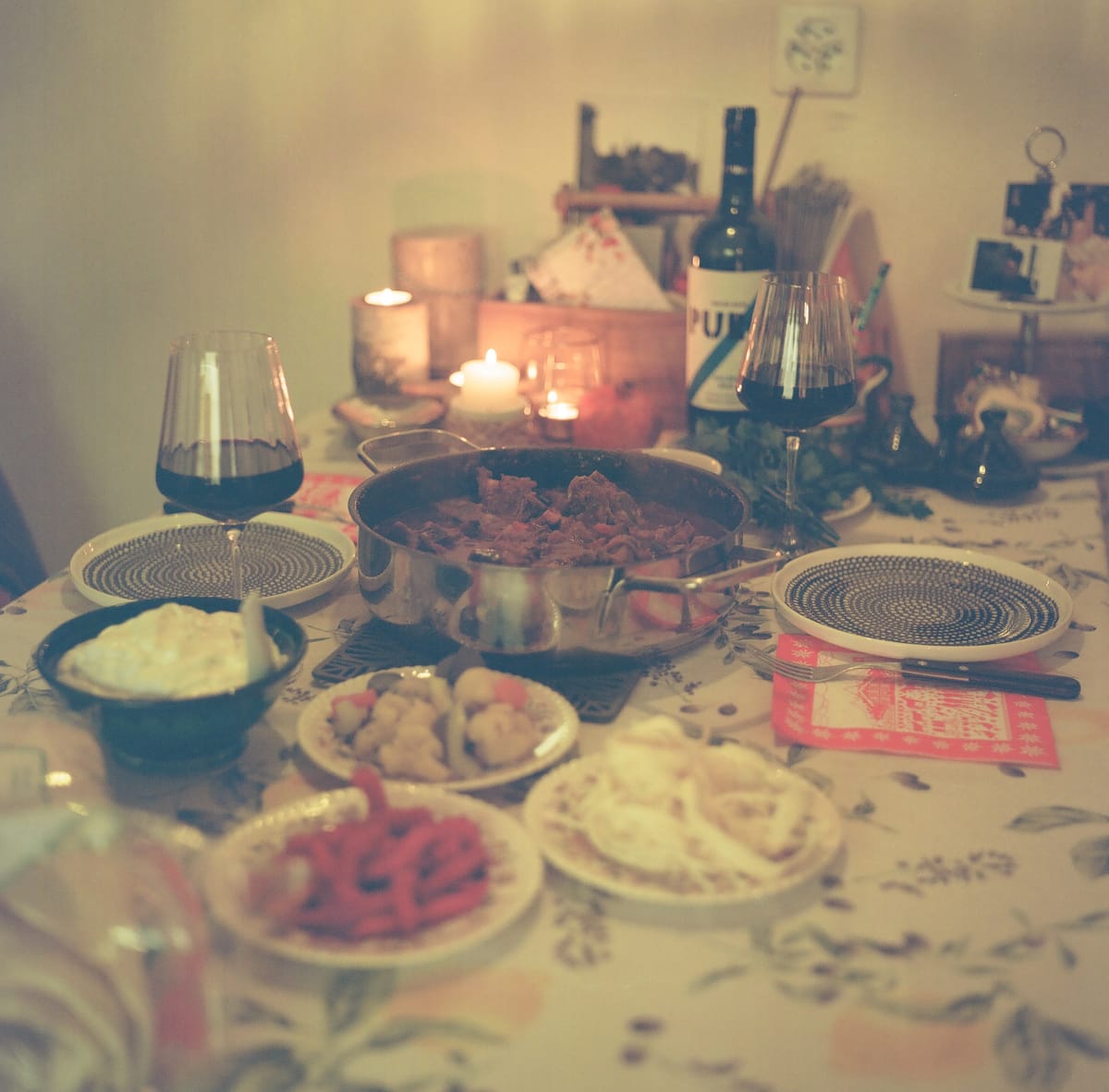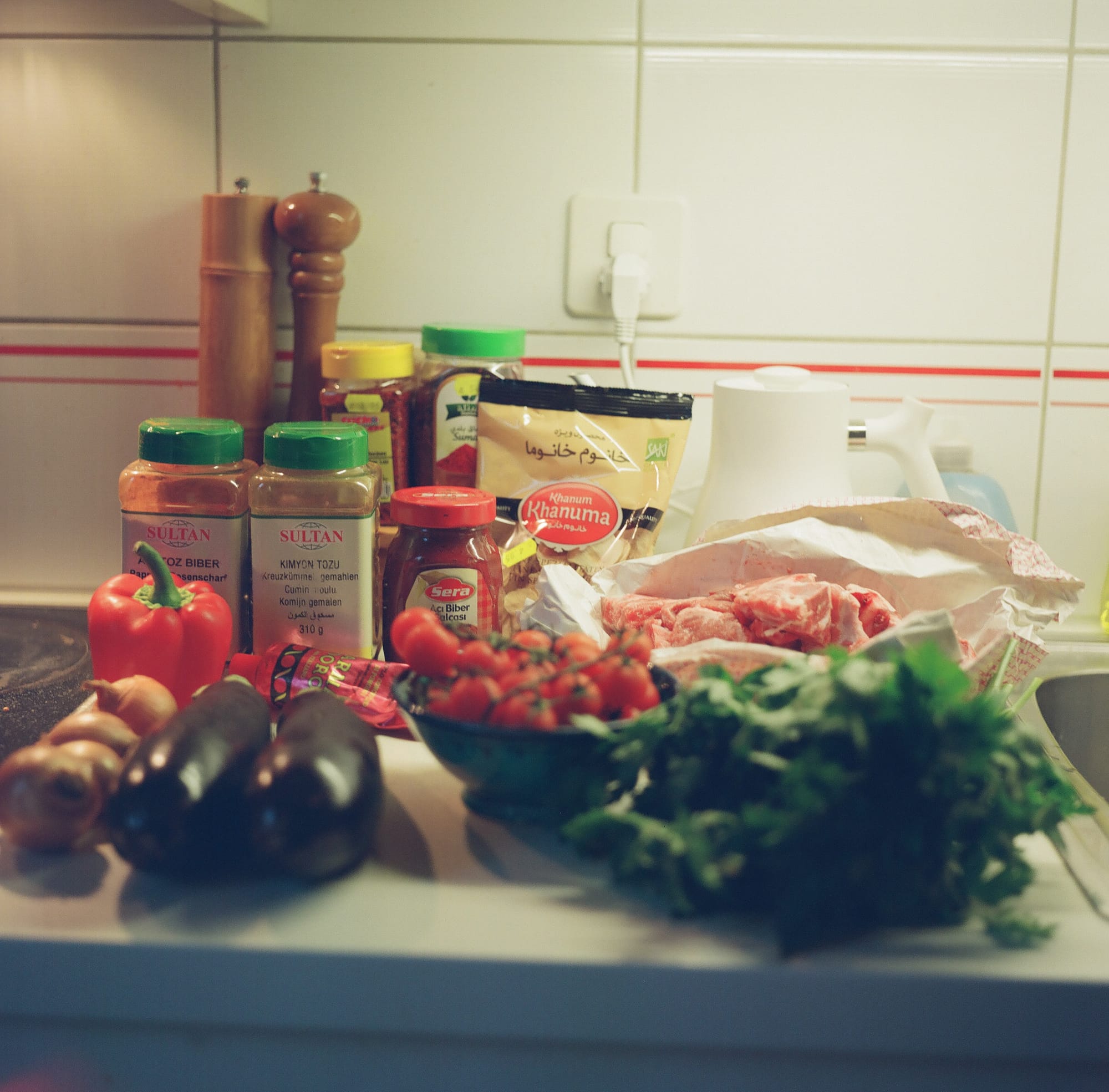What to eat KURDISTAN 🟥☀️🟩 Tirşik (Kurdish lamb and eggplant stew)
As the Kurds count the mountains as their great friends, this too is the source of a national dish known in the Kurmanji dialect by the name tirşik, a lamb and eggplant stew slow-cooked with pepper, sumac, tomato and a few other ingredients and spices.

Tirşik (Kurdish lamb and eggplant stew)
Published February 7, 2025 · by Amanda Rivkin Häsler
Perhaps the best way to begin to tackle a conversation about the national dish of a people without a country is to begin with an axiom about the Kurds by the Kurds who are said to “have no friends but the mountains.” Lacking a cohesive unified state structure, there is no official or singular tourism board or leadership entity that can proclaim one dish to belong to the nation.
Rather, like other communities that have been forced by geopolitics into multi-ethnic states where they are not the majority and inter-ethnic tensions in their communities to be nomadic at times, there are dishes that are shared within the Kurdish community and others that are an adaptation of outside flavors. To call any one meal “the dish of the community” is a misnomer and also misleading. There are many dishes and flavors depending on where a family is from originally, where they may have had to relocate to and what incomes can afford to put on the table at mealtime.
As a non-Arab ethnic group scattered across at least four countries, eastern Iraq and northern areas of Syria, Iraq and Iran, the Kurds are further divided by two primary Kurdish dialects, known as Kurmanji and Sorani. In eastern Turkey, the Kurmanji dialect is more prevalent, whereas on the Iran-Iraq border, one is more likely to encounter the Sorani dialect of Kurdish.
While Kurdistan is a broad territory, the closest thing to a Kurdish state that has formed is in northern Iraq in the aftermath of the 2003 US invasion that toppled the late dictator Saddam Hussein. In eastern Turkey, an active insurgency has been underway for decades, with both a political and military wing and the leader, Abdullah Öcalan, in a Turkish prison on Imrali island for the last 25 years. In northern Syria, the Kurds worked with the Americans to push back the fundamentalist jihadi insurgency that became known alternatively by the acronym ISIS, Islamic State or Daesh, the last playing on a deprecating name for the group in Arabic.
While culture and customs are often dictated as much by stability as wealth, certain aspects of the traditional Kurdish meal likely owe much to both factors. A traditional Kurdish meal for instance is enjoyed seated on the floor around a spread of items laid out on a tablecloth, communal-style in the center. Such family-style meals are easily transportable and do not require an investment in furniture beyond a table cloth, cushions, cutlery and dishes.

As the Kurds count the mountains as their great friends, this too is the source of a national dish known in the Kurmanji dialect by the name tirşik, a lamb and eggplant stew slow-cooked with pepper, sumac, tomato and a few other ingredients and spices. While there is no one way to make this, nor one Kurdish national dish, it is the dish I had most frequently traveling in Kurdish areas of Turkey, staying with a Kurdish family and encountering Kurdish food in my travels. All the ingredients can easily be found either at market or in the mountains.
While the precise origin story may never be known due to the precarious nature of record keeping in the security and economic circumstances described, one can tell that it is a dish very much rooted in the land and nature’s gifts to the Kurdish people. It is hearty, delicious, economical and easy to share and cook. It is also fresh, something Kurdish cuisine places great emphasis on given the wealth the land affords.

Recipe
Ingredients:
1 kilo of lamb chunks with bones
2 eggplants
Maldon salt
4 small yellow onions
Sumac
Pul biber
Sunflower seed oil
1 red bell pepper
250 grams tomatoes
5 pieces of sliced Persian garlic
Cumin
Hot pepper
Tomato paste
2 tablespoons acik biber sauce
Step 1: Cut the eggplants into cubes, sprinkle with salt and set aside.
Step 2: Cut the onions into small pieces and set aside.
Step 3: Sprinkle sumac, pul biber and salt over the lamb.
Step 4: Add sunflower seed oil into a pan and turn to high heat. Add the lamb with the side covered in spices face down. Add more sumac, salt and pul biber to the side face up and then turn over until it browns on both sides and remove from heat. Set aside. Then add the onions and turn down heat to low to medium heat. Stir occasionally.
Step 5: Chop up red bell pepper into cubes after removing stem and inside. Set aside. Cut up tomatoes as well and set aside.
Step 6: Add a cup of boiling water to a bowl with the Persian garlic. Set aside.
Step 7: When all ingredients are prepared and onions are brown, we can begin to bring the stew together. First add tomatoes and red bell pepper and turn heat up to medium.
Step 8: When tomatoes begin to soften, add two tablespoons of cumin, hot paprika and tomato paste. Stir together.
Step 9: Add eggplant and combine with tomato ingredients. Allow to cook a few minutes. Add lamb and two tablespoons of acik biber sauce, Persian garlic water and stir all together. Cover, turn to low heat and let steam cook for approximately 75 to 90 minutes, stirring occasionally.
Step 10: Serve with rice and/or pita and for condiments, pickled vegetables Middle Eastern style such as turnips, cauliflower, sweet peppers and yogurt or hair cheese (çeçil peyniri), as well as parsley and çoban salata (tomato and cucumbers as a spread or Kurdish homestyle, with a table cloth laid out on a rug with cushions around for your guests. To drink, serve with beer or ayran or even red wine, depending on the customs and preferences of your guests.
Learn where to eat Kurdish food in Switzerland.
Follow our social media pages @swissglobaldining on Instagram, TikTok and YouTube